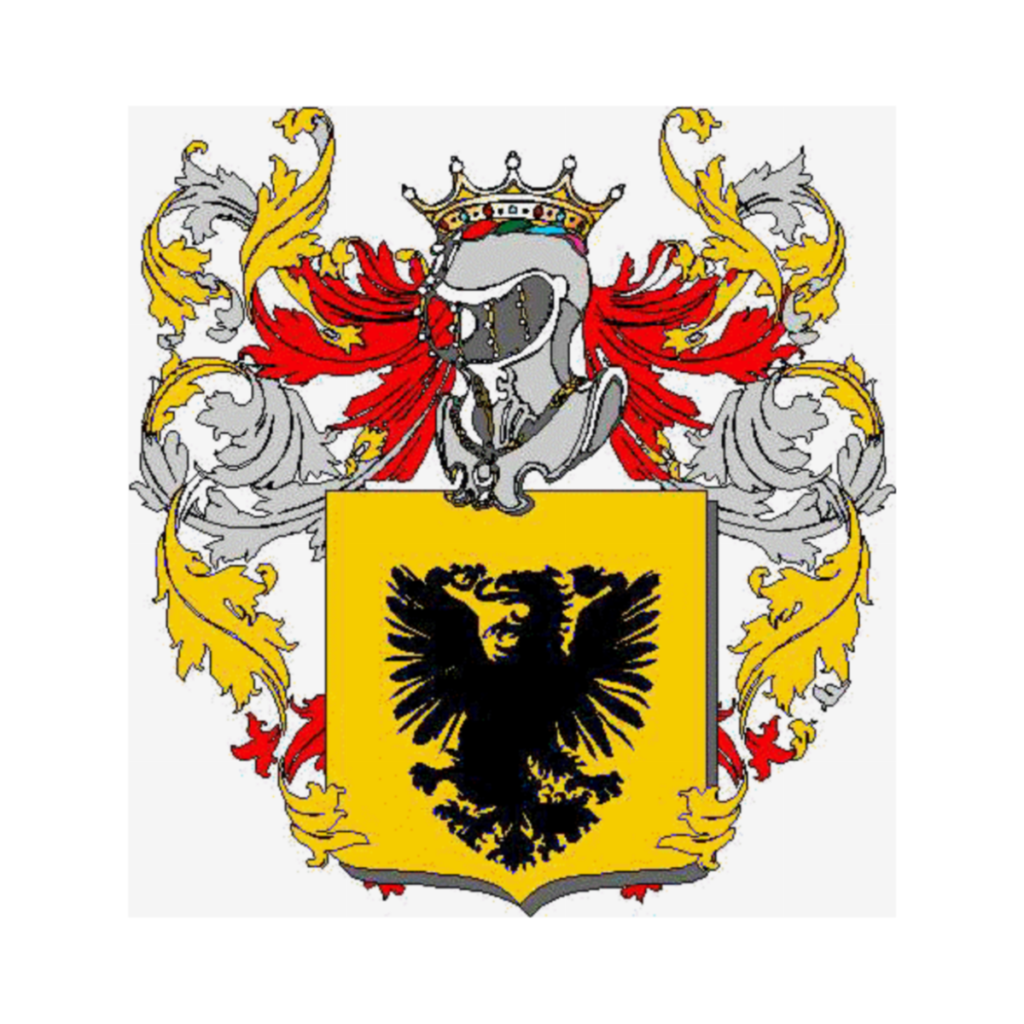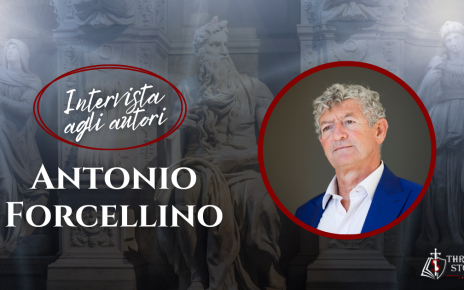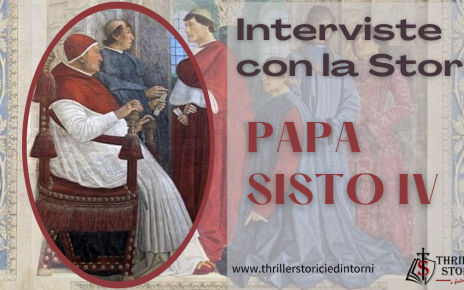TSD is glad to participate to the Blog Tour organized by Newton Compton Editori in order to promote the new novel by Alex Connor: “The secrets of the Pope’s Lover”. Our site have had the pleasure to virtually meet the author and ask her some questions about her book.
Good morning Alex and welcome on our website. How did you come up with the idea of telling the story of the Tuscolani family in this new saga?
❞
I was fascinated by the whole idea of the Church and Popes being controlled by the nobility, and worse, the so-called ‘harlots’ of the Tusculani family. The very word ‘Pornopapacy’ caught the attention and I needed to find out how true this actually was. After all, historians like Lipruand, Bishop of Cremona, had their own reason to defame the family, and rivals often wanted to blacken the name of the rich and very powerful Count and Countess of Tusculum. Much as Lipruand might denounce the excesses of the Tusculani women, when he served under Constantine VII as an apprentice diplomat he did not reject the hospitality offered, being carried on the shoulders of eunuchs into the Assembly Hall at Constantinople….
The Medieval times were dangerous and little known, which presented a challenge and made me want to uncover the reality. The rich could shield themselves with money, but the lives of the poor were dirty, fearful, and food was scarce. Even the Church – the very place that should have offered succour – turned a blind eye to the suffering and Rome became a wilderness, a hollow carapace of its previous glory. The further I dug into my research, the more I discovered, together with the history of the Tusculani and the infamous Marozia.
Was she truly a Medieval femme fatale? Or merely a product of her lineage and era? The answer was waiting to be unearthed. And yet however much I wanted to investigate the period of 900 – 990 AD I soon realised that the information was limited, and often contradictory! Doggedly, I read and checked what facts I could find, but little of this period had been written; it was an unknown country, full of bandits, assassins and lethal women. What better reason is there to share the story of the Tusculani and the puppet Popes?
In short, I was hooked.

What affinities and what differences can we find between Borgia family, protagonist of the previous saga, and Tuscolani family?
❞
The Borgias and the Tusculani differed in one particular matter; the Borgias were ruled by men, the Tusculani by women.
Yes, Lucrezia Borgia was important, wedded and used by Alexander VI for political ends, but she did not set the agenda, whereas Theodora and her daughter, Marozia, were pre-eminent, standing alongside men and defying everything that had gone before them. It was The Dark Age, when few people had power – and women had less. Yet Theodora, wife to Theophylact I, became Senatrix of Rome. She had equal eminence with the Count – an impressive achievement for a woman who had once worked as a prostitute. Even more impressive was that she passed her ruthlessness onto her daughter – together with her amorality.
The Borgias mastered Rome as a Papal family.
The Tusculani mastered the Popes as a noble dynasty.
“The Pope’s Lover’s Secrets is set in a dark period in the history of Rome and the papacy, the so-called ‘Saeculum obscurum’. What can you tell us about this period?
❞
It is now referred to as The Dark Age – and for good reason. Rome was virtually destroyed after the Sack of Rome and the endless invasions and political pogroms, instigated by neighbouring countries or states. The once glorious city had been reduced to rubble; the squares becoming cattle grounds, market places for merchants, and the numerous slave traders. Prisons were overfilled with those defeated in battle and torture was brutal and often public. Where once there had been statues of Caesars displayed in glorious Forums, there was little remaining. Anything of value had been stolen either by invading enemies, or purloined by the nobility who had deserted the dejected city for their palaces in the hills. The town of Tusculum, although not wealthy, escaped some of the worst privations being the property of Count Theophylact I, but Rome suffered.
With no Civic nor Papal money offered for repairs or renewal, the buildings became ruins, left to decay. The poor, who barely existed on the available produce, were starving and feral, sheltering and sleeping amongst the devastation, Romans terrorised by the corrupt few who held power. The Saeculum Obscurum was the lowest point in the history of the Catholic Church, a period when not only Rome, but the Papacy itself, was in chaos. With endless plotting and assassinations there was havoc, eight papal elections within nine years, a disastrous carousel of Pontiffs that had not the power – nor the will – to defy the Tusculani.

Sergio III is remembered as a cruel and tyrannical Pope manipulated by women more cunning than him. How do you see this figure?
❞
When I first saw an image of Pope Sergius III my initial reaction was a slow, measured blink. Usually I never judge a historical character on how appealing or unappealing they are, but the large bald head, downturned mouth and fleshy lips – together with his stocky, bulbous form – made him into almost a cartoon image of a tyrant. Surely this was an exaggeration? A deliberate ploy by his detractors to make him seem vile in appearance as well as behaviour? Surely this couldn’t be the lover of Marozia? And then I remembered how often, down the ages, power and money can make even the most unremarkable man acutely desirable.
What is certain is that Pope Sergius III was feared and hated by the people of Rome, for whom he cared little, offering no Papal monies for housing or the improvements of their living standards. The onlyrestoration Sergius allowed was that of the Baptistry, and that was undertaken for his own glory, the rest of the ruined city left to decay. Indifferent, cruel and cunning, Sergius was the perfect ally for the Tusculani. However, as they were related, it begs the question: was Sergius their pawn, or their accomplice? Both, I believe.
It was difficult to find much to commend Sergius: he was greedy, ambitious and lascivious, all traits that made him the perfect consort for Marozia, whose parents, Theodora and Theopylact, were of the same ilk. And yet my further research uncovered Sergius’s bravery and determination, and I was impressed by his tenacity.
He won the Papal throne.
He lost the Papal throne.
Then he won it again.
Admittedly at the cost of murdering two other Popes, but this was Medieval times and there was no internet, no recourse to justice, and so power was absolute and evil flourished. When Sergius III was Pope he was never challenged; if you spoke against him, you were imprisoned or murdered.
Which brings me to Sergius’s intimates, the women in his life. Was Sergius manipulated by Theodora? Did she slide her daughter into his bed as a political ploy, knowing he would hardly reject a fifteen year old beauty? Or did Marozia begin the manipulation, looking upon the Pope as a way to fulfill her ownambitions? Of course, if we look at it from Sergius’s point of view, he might have been more than willing to be seduced by Marozia and by such means bind himself further to the Tusculani. But as their affair progressed I suspect that the Pope saw his own vices reflected in his teenage lover. And perhaps, when she became pregnant, he might even have begun to fear her. Perhaps it was with a sense of relief that Sergius III saw Marozia wed before the birth of their illegitimate child, conveniently marrying the murderous Alberic I of Spoleto, another ally of her father’s.

Three women hold the strings of this tale: Theodora, wife of the Roman senator Theophilact, his daughter Marozia and Sister Felicita. What role did these women play for the papacy of Sergio III?
❞
Is it true that Theodora was once a prostitute? There are some that are quoted as saying so, but then again, was it just a scandalous attempt to defile her name? I think not, Theodora did a very capable job of besmirching her own reputation without the help of others. She was notoriously carnal, taking lovers from slaves and cardinals, and rewarding those that pleased her most with gifts. (Even with the Papal crown itself.) And she made no attempt to hide her sex life from her husband. Apparently Count Theophylact might hold a blade to a man’s throat, but Theodora seduced her victims into submission.
I have to admit that his nonchalance surprised me – was the Count disinterested in his wife, or infatuated enough to excuse her behaviour? I came to believe the latter. Perhaps his libido did not match Theodora’s and he was willing to have someone else do the hard work whilst he concentrated on becoming Consul of Rome. After all, despite her infidelity, Theodora was the perfect spouse, never once deviating from her familial ambitions. As for the role she played in the papacy of Sergius III, it is obvious – she manipulated a willing daughter into the bed of a corrupt Pope, and in doing so ensured the Tusculani boot was placed firmly on the neck of Sergius III and Rome.
As for Marozia; she would have grown up watching her mother’s manoeuvres and probably admired them. She is recorded as being promiscuous and beautiful and all women know that beauty and carnality can be lethal. They say that everyone is a product of their upbringing, so if Marozia saw unashamed sexual intrigues taking place around her constantly – without censure from her father – it probably seemed natural to her. Enjoyable and profitable. After all, her mother did not merely indulge herself in bed, but intellectually, becoming the Senatrix of Rome. What an example to follow… Marozia was ambitious, and even young she had a ruthless streak. So she probably did not see the Pope as a holy figure; she saw him as her father’s ally, a means to an end. One of which her parents approved. When seen this way, it is no longer shocking to know she seduced a middle aged Pontiff at the age of fifteen. She had been well taught. And besides, being the Papal mistress bought respect – albeit grudging – from the populace. Sergius became besotted by her; indulged her, lavished gifts and servants – and what did she have to do for such rewards? The answer was in using the oldest trick on earth – sex.
With regard to Sister Felicita, she is a riddle and remains so until the third book when she reveals herself. At first she was a religious woman without belief. A humble nun with hidden vanity. A celibate woman who was willing to hire and control the whores that frequented Sergius’s palazzo whilst he was still cardinal in Caere. She makes no direct comment on the subject of sex, but maintains an aloof distaste for the folly of the dissolute Sergius III, and in doing so gains his respect. At certain times she speaks to the Pope frankly, but without manipulating him, and has no hesitation in leaving his service and disappearing, only to re-emerge later in Rome, when Sergius hires her again. I believe that of all the women that came into the Pope’s life Sister Felicitas was the one he truly admired.
Sergius would never have tried to seduce Sister Felicia, because despite her appeal, he would not have dared. It was not merely because she was a nun, but because he saw in her a dignity that neither Theodora nor Marozia ever possessed. He also had the insight to recognise Marozia’s vitriolic envy which led to the nun’s downfall. In fact, it is the only time in the novel when Sergius shows pity for anyone, when he sees the nun’s beauty destroyed.
So in the end I would say the three women played very different roles in the papacy of Sergius III. Theodora was a statistician; Marozia was an obsession; and Sister Felicitas was an enigma.

Among the many characters in the novel, the figures of Father Sanzi and his pupil Angelo stand out: are they real characters or are they fictional characters?
❞
Actually both Father Senzi and his ward, Angelus, are fictional characters. We had to have some sympathetic characters amongst the many duplicitous and self serving players.
The priest is a ‘good’ man, but not unbelievably good. He chaffs against his fate at times and shows fear, which any man would do in a period where lives were not only harsh, but liable to be cut short by a wrong word or deed against those in power. His love for Angelus, the anonymous boy he cared for after he was rescued from the Baptistry fire – is steadfast. He becomes the disfigured youth’s protector and in loving Angelus, the priest is embroiled in his ward’s relationship with Tullia, sister to Marozia. Against his better judgment Father Senzi tries to keep them apart, encouraging Angelus’s artisitc ability, but when he realises the depth of their feelings he endangers himself to safeguard them. He exemplifies the true meaning of Christianity, set against the indifference and depravity of the Pope.
Circa 900 AD there were always parish priests, holy men who were hired – in Tusculum by Count Theophylact I – to hold church services, hear confession, tend the sick and orphaned children, and support the running of the town. The pompous clerics that Father Senzi deals with later act as a direct contrast to him. They pontificate, seeing themselves as carrying on the traditions of the Senate of Rome, and do nothing; whilst the priest continues running the duties of the towns quietly and efficiently. He is as proficient in treating a broken leg as in giving advice to a grieving mother. He is also compassionate, human and humorous, in stark contrast to the iron chill of Theophylact and the devious sexuality of Theodora and Mazoria. Love comes easily to him – as does disgust at the brutality meted out to Angelus.
Angelus is a favourite of mine and I created him because I am intrigued by Janus, the two headed god. The idea of a youth being both handsome and mutilated, of having such duality, was fascinating. Because of his burns, Angelus is mocked and bullied, and as a result he has withdrawn into a private world. There he remembers images that he saw in the flames which had injured him so grievously in the Baptistry fire. Yet although he can remember these demons, he cannot recall who he was before the accident, nor if he had a family. When no one claims this unknown boy, Father Senzi takes him as his ward and encourages a talent that is the only reality in Angelus’s life. Until he meets Tullia.
His character is as divided as his facial appearance. He is withdrawn, but defiant. He is solitary, but yearns for company. He is obedient but combative, infuriating Theodora when he stands up to her. To me, Angelus represents hope; he does not dare to believe that he is loved, and in his reticence, inspires it.
Also, having Father Senzi and Angelus in the novel means that I can write about my passion – art. Before I began this trilogy Medieval art was an area about which I knew little, so it was a joy to uncover – amongst the Papal sludge and Tusculani mire – some luminous treasure!

The Secrets of the Pope’s Lover is the first in the Vizi Capitali Saga: can you give us some previews about the following novels?
❞
Well, without giving away too much and spoiling the trilogy, I can say that the death of Sergius III causes havoc. Theodora’s insatiable sexual appetite finds a new focus, and a very advantageous ally. As for Marozia, her ambition coaligns with Alberic’s – but only as long as it suits her. With the birth of her second son, Marozia’s influence accelerates and her power becomes vicious. No one is immune to her ruthlessness, and as Book Two ends she has succeeded in overpowering the leading figures in Rome. But someone is watching – and the nun is waiting for her time.
Book Three brings further treachery in Rome as Theodora and Theopylact meet with unexpected fates. Another Pope is placed on the Papal throne, one that Marozia can manipulate and bully, her control absolute. At this point Tullia and Angelus return to Rome, and Quinitius finally savours the revenge for which he has waited so long. But the final outcome must remain a surprise! Let me just say that Marozia becomes the victim of her own greed and cruelty as those she trusted turn against her.
In short, the next two books bring more plotting, more murders, more bloodshed, more sexual intrigues, and more Popes! Here I must admit that I have loved writing about this period in history – the Pornopapacy – plotting my course through the maze of Papal chaos and conniving nobles. Some of the characters I have grown to love, others have repelled me, and a few will never leave my thoughts. I can only hope some of my readers will feel the same.




